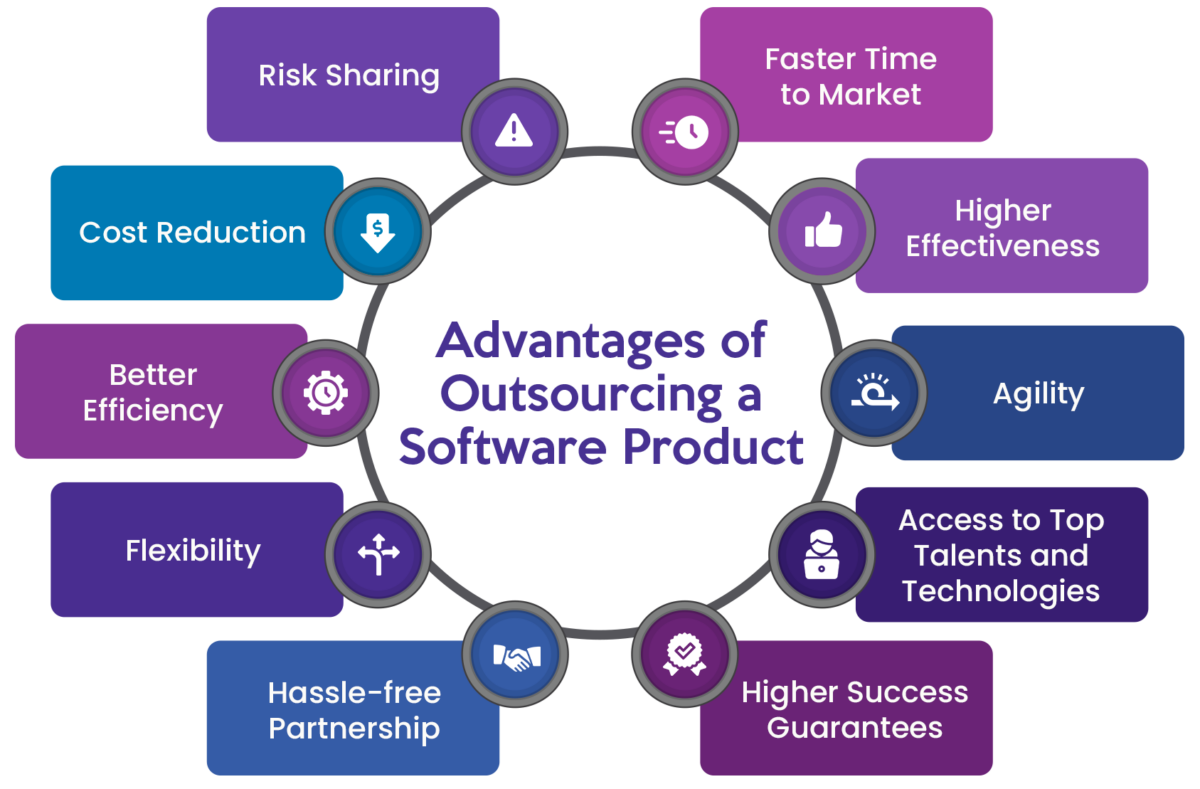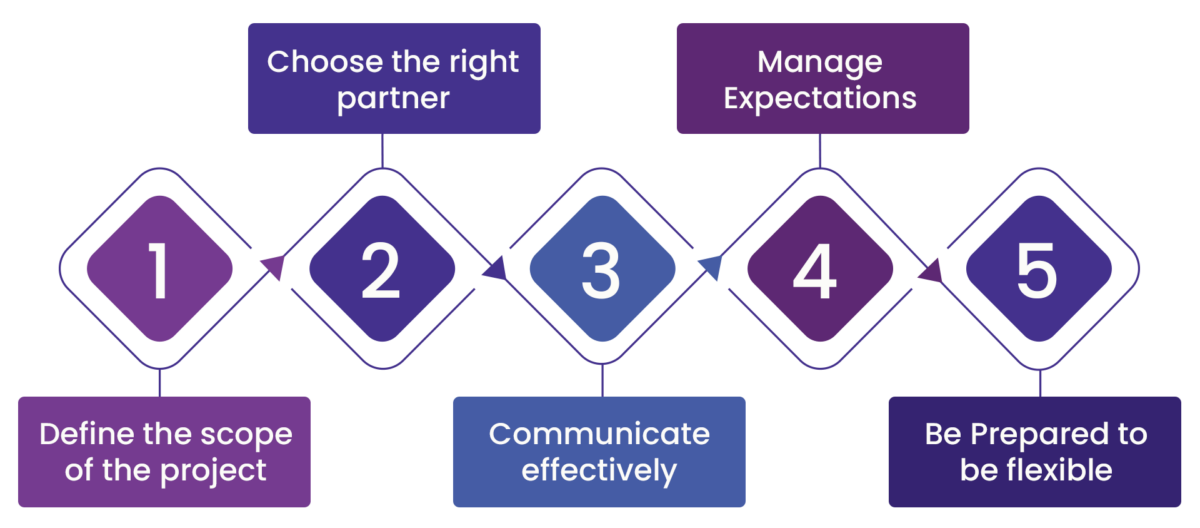Outsourcing product development involves engaging third-party vendors, both domestically and overseas, to manage all or part of the product development process. It includes design, prototyping, manufacturing, and sometimes even marketing. This is typically done to leverage the outsourcing partner’s specialized skills, labor cost advantages, or resources.
This article will explore the benefits of outsourcing product development, provide a step-by-step guide on how to do it effectively, identify factors to consider, share tips for success, and outline potential challenges with solutions.
Benefits of Outsourcing Product Development

Cost Savings
Outsourced product development can lead to substantial cost savings, particularly by reducing labor costs and overhead expenses associated with in-house operations. These savings, which are a common benefit when companies outsource product development, particularly in software development, can be strategically reinvested into other vital business areas. This reinvestment can encompass various sectors, such as marketing initiatives or enhancements to existing products, thereby maximizing the advantages of utilizing outsourced product development services. By choosing to outsource product development, companies save money and open up opportunities for growth and innovation in other core areas.
Improved Customer Satisfaction
Businesses can develop and deliver products that fulfill and surpass customer expectations by harnessing the specialized skills and advanced technologies offered by outsourced product development companies. This high level of quality often translates to a surge in customer satisfaction and loyalty. Compared to the limitations an in-house team might face due to resources or skills, outsourcing software product development often gives companies access to global expertise and cutting-edge tools that can dramatically boost the quality of their offerings. As such, outsourcing product development services becomes a strategic move that improves product quality and positively impacts customer relationships and overall business reputation.
Access to a Larger Pool of Talent
Outsourcing opens doors to a global talent pool, enabling access to experts in specific fields that might not be available locally.
Improved Efficiency
Using specialized tools and methodologies, an outsourced product development team within a professional outsourced product development company can significantly streamline the product development process, particularly in software development projects. This efficiency leads to shorter development cycles and contributes to a noticeable cost reduction, as the optimized process often means fewer resources are consumed over the project’s lifespan.
Consequently, this enhanced efficiency facilitates a faster time-to-market, enabling businesses to launch their products ahead of competitors. In highly competitive industries, where timing can be a pivotal factor in success, strategic engagement with outsourced product development companies to expedite product launch becomes essential.
Risk Mitigation
Outsourcing distributes some of the risks associated with product development. By engaging experts in the field, you reduce the risk of errors or delays, which can be costly. It also allows businesses to adapt quickly to market changes without significant internal restructuring.
Focus on Core Competencies
By outsourcing non-core activities like product development, companies can concentrate on their core competencies such as strategy, sales, and customer relationship management. This focus leads to a more robust overall business strategy and execution.
Scalability
Outsourcing provides the flexibility to scale operations up or down based on demand. This is particularly beneficial for businesses with fluctuating needs, enabling them to adapt quickly without the hassle of hiring or firing in-house staff.
Access to Advanced Technologies
Outsourcing firms often invest heavily in the latest tools and technologies. Partnering with these firms provides access to cutting-edge technologies that might be too expensive or complex to implement in-house, leading to superior products.
Enhanced Competitiveness
Businesses can enhance their competitive edge by leveraging the combined benefits of cost savings, quality improvement, access to global talent, and advanced technologies. They can offer better products at competitive prices, expand into new markets, and respond to changes more swiftly.
Sustainability
Outsourcing can play a vital role in contributing to sustainability by enabling resource optimization, especially when engaging with the world’s leading product developers who emphasize eco-friendly practices. Collaborating with an outsourcing company that adheres to environmentally responsible methods ensures a reduced environmental impact on the product development process. This approach, coupled with the alignment of a fixed price model, fosters efficiency and minimizes waste, aligning the project with sustainability goals. By choosing an outsourcing team that embodies these values, companies optimize their resources and align their product development efforts with broader societal interests in environmental stewardship.
Steps for Outsourcing Product Development Effectively

1. Define the Scope of the Project
Understanding Requirements
At this stage, it’s crucial to have a clear and comprehensive understanding of the project requirements. This includes determining the goals, defining specific deliverables, setting timelines, and outlining quality standards.
Budgeting
Establishing a budget is an essential step in the planning phase of any project, as it will profoundly influence your choice of partner and shape the project’s overall direction. By creating a well-defined budget, a clear and comprehensive understanding of all potential costs, both expected and unexpected, is taken into account. This not only sets clear financial boundaries for decision-making but also provides a roadmap for managing resources throughout the project. It acts as a financial compass, ensuring that the project stays on course while maintaining fiscal responsibility, thus preventing unnecessary overspending and guiding the successful completion of the project within the defined economic framework.
Risk Analysis
Identify potential risks and develop strategies for managing them. This includes technical, financial, or operational risks that may affect the project’s success.
2. Choose the Right Partner
Research Potential Partners
Investigate potential outsourcing partners by examining their expertise, track record, reputation, and alignment with your project’s goals and culture.
Evaluate and Compare
When selecting a partner for your project, it is essential to compare the shortlisted candidates based on various critical criteria that align with the project’s needs and goals. These criteria include the cost of their services, the quality they provide, their technological capabilities, and how well they fit with your company’s culture and values. Analyzing these factors in detail helps make a more informed decision that considers multiple aspects of the partnership, ensuring that the chosen partner will not only meet the budgetary constraints but will also deliver the desired level of quality, utilize appropriate technology, and align with the organizational culture. This comprehensive comparison fosters a more seamless integration and collaboration, paving the way for a successful partnership.
Legal Agreements
Draft clear contracts outlining the scope of work, payment terms, intellectual property rights, confidentiality, and other vital aspects. This legally binding document will be the foundation of the relationship.
3. Communicate Effectively
Develop a Communication Plan
Determine the communication channels, frequency of meetings, points of contact, and escalation procedures. Clear communication fosters trust and ensures that everyone is on the same page.
Establish Collaboration Tools
Utilize modern collaboration tools for project management, file sharing, and communication to keep the project on track and enhance transparency.
Cultural Sensitivity
Recognize and address any cultural differences that might affect communication and collaboration.
4. Manage Expectations
Set Clear Goals
In the planning phase of any project, it is crucial to outline specific, measurable, achievable, relevant, and time-bound (SMART) goals. These well-defined objectives serve as a roadmap that provides clear direction and focus for all team members. By ensuring that the goals are specific, you eliminate ambiguity; by making them measurable, you set clear benchmarks for success; by ensuring they are achievable, you align them with available resources; by making them relevant, you ensure alignment with the project’s overarching purpose; and by making them time-bound, you establish a clear timeline for completion.
Together, these SMART goals act as a cohesive framework that guides the project, keeping it on track and ensuring that everyone involved understands what needs to be achieved and by when, thus contributing to a more focused and effective execution.
Monitor Progress
Implement regular checkpoints to review progress, address concerns, and make necessary adjustments. Regular monitoring ensures alignment with the project goals.
Feedback and Adaptation
Encourage open and candid feedback from both parties involved in the project, and maintain a willingness to adapt and make necessary adjustments as the project evolves. This approach fosters a collaborative environment where ideas and concerns can be freely expressed and addressed. By embracing the iterative nature of development and being open to change, you create a dynamic and responsive project environment. This adaptability ensures that the project remains aligned with its goals, even as new challenges or opportunities arise, thus promoting a more resilient and successful development process.
5. Be Prepared to be Flexible
Embrace Changes
Outsourced product development often involves unexpected changes. Being flexible and open to alterations can lead to better solutions and innovation.
Plan for Contingencies
Have contingency plans in place for scenarios like changes in scope, delays, or unforeseen challenges.
Encourage Innovation
Allow room for creativity and innovation from the outsourcing partner. Sometimes, deviating from the original plan leads to enhanced outcomes.
Factors to consider when outsourcing product development
Quality of Services
When evaluating a potential partner for a project, it is essential to assess the quality of the services offered thoroughly. This assessment should include a close examination of the talent’s expertise, the technology used, and how these factors align with the specific needs and goals of the project. Understanding the capabilities of the team and the tools they employ provides insight into their ability to deliver the desired outcomes. By looking at both the human and technological aspects, you can gauge the potential partner’s proficiency and innovation, ensuring that they meet the standards necessary for a successful collaboration. This detailed evaluation forms a vital part of the decision-making process, contributing to a well-matched partnership and capable of achieving the project’s objectives.
Availability and Accessibility
Ensure that your outsourcing partner is available when needed and that communication channels are open and efficient.
Cost
Balance quality with cost, understanding that the cheapest option may not always provide the best value.
Cultural Compatibility
Consider cultural differences that might affect communication and collaboration.
Tips for Successful Product Development
Foster Open and Clear Communication
Clear communication stands as a fundamental pillar to achieving success in any project or collaboration. It involves more than just conveying information; it’s about fostering understanding and building a strong relationship between the involved parties. Regular meetings, transparent conversations, open dialogues, and responsiveness to questions or concerns all contribute to a robust communication strategy. By ensuring that everyone is on the same page and that expectations are clearly understood, you lay the foundation for a successful partnership.
This approach builds trust, encourages collaboration, and helps in promptly addressing any issues that may arise, leading to a more cohesive and effective working relationship.
Maintain a Consistent Brand Voice
Ensure that your outsourcing partner understands and adheres to your brand’s voice and identity.
Use technology to your advantage
Make use of and leverage modern tools designed for collaboration, project management, and communication to enhance the efficiency and effectiveness of the working relationship. These advanced tools, often cloud-based and accessible from various devices, facilitate seamless integration among team members, whether they are in the same location or spread across the globe.
Modern technology offers many solutions to streamline processes, from real-time updates on project progress to shared workspaces for collaborative efforts and platforms that enable clear and immediate communication. By adopting these tools, teams can work more cohesively, track progress more accurately, and communicate more transparently, leading to a more productive and harmonious project environment.
Continuously evaluate and improve the outsourcing process
Regularly review and refine the process to ensure it remains aligned with your business goals.
Potential Challenges of Outsourcing Product Development and How to Overcome Them
Language Barriers
Choose partners with strong language skills or employ translation services to avoid misunderstandings.
Time Differences
Manage time zone differences through careful scheduling and by setting clear deadlines.
Maintaining Control Over the Customer Experience
Set clear expectations, maintain close communication, and conduct regular reviews to ensure quality control.
Outsourcing product development offers numerous advantages, such as cost savings, improved customer satisfaction, access to global talent, and efficiency gains. The key to success lies in carefully defining needs, researching options, implementing a robust plan, and continuously evaluating the process.
Final Thoughts On Making a Successful Outsourcing Decision
Outsourcing product development is a strategic decision that requires thoughtful planning and execution. By understanding the benefits, following the steps outlined, considering essential factors, and applying the tips shared in this article, businesses can make a successful outsourcing decision that aligns with their goals and adds value to their customers. If you’re considering this path, it may be beneficial to explore partnering with The New Workforce, a seasoned player in the outsourcing field. Their extensive experience and dedication to client success will surely help your business achieve its goals when outsourcing product manufacturing, providing the support and expertise you need to make your project a resounding success.



Leave A Comment
You must be logged in to post a comment.